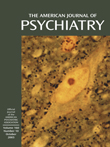Increase in Concentration of Waking Salivary Cortisol in Recovered Patients With Depression
Abstract
OBJECTIVE: Dysfunction of the hypothalamic-pituitary-adrenal (HPA) axis with elevated plasma cortisol levels is characteristic of acute major depression. However, it is unclear whether HPA axis abnormalities are present in fully recovered patients. An increase in salivary cortisol levels after waking provides a simple, dynamic measure of HPA axis activity. The authors measured this increase in recovered depressed patients and in a healthy comparison group. METHOD: Salivary cortisol levels were measured upon waking and at 15-minute intervals for the next hour in 31 medication-free, recovered depressed patients and in 31 matched healthy comparison subjects. RESULTS: The increase in salivary cortisol levels that followed waking was significantly higher in the patients. CONCLUSIONS: Greater secretion of cortisol may be present in depressed subjects after clinical recovery and withdrawal of medication. This may put patients at risk of further episodes of depression as well as comorbid medical conditions, such as coronary heart disease.



